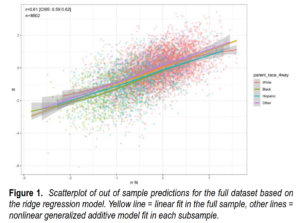Putting these in writing in a single place for ease of reference. Unfortunately, no one wrote down all these predictions some years ago to show they really were predictions, but one could probably find textual evidence for many of these in various papers and blogposts. Some of them have been supported already, and some are still waiting for a first estimate.
- True polygenic scores will differ by ancestry (“race”) for various traits, including intelligence, in ways that align well with phenotypic gaps
- These refer to the error-free (“true”), unbiased polygenic scores (not necessarily based on linear models).
- This is essentially a generalization of Cheverud’s conjecture generalized to means structure (“Cheverud’s extended conjecture”).
- Related: Ancestry related differences in true polygenic scores will explain the mean differences between socially defined racial groups.
- Related: Ancestry related differences in true polygenic scores will mediate the effects of genetic ancestry. In other words, ancestry itself is not causal but it is correlated with the true polygenic scores for desirable traits and their later social outcomes.
- Related: As our estimated polygenic scores improve, they will keep correlating with phenotypic scores for ancestry means. Causal variant-based scores and sibling-based scores will also show the same gaps while being less influenced by systematic errors.
- True polygenic scores for racial visual traits, chiefly skin color, will have poor validity to predict major social outcomes (e.g. income) and psychological traits (e.g. intelligence) when genetic ancestry is taken into account.
- One way of saying that colorism is false, because skin color is not much causal for important things.
- Related: genes and pathways involved causing racial visual traits will not show particular relations to social outcomes or psychological trait variation.
- Test of divergent selection will find that true polygenic scores show evidence of divergent selection for traits such as intelligence and height.
- This will also show up for related units such as genes and pathways. In particular, such units related to the traits of interest will show evidence of divergent selection.

